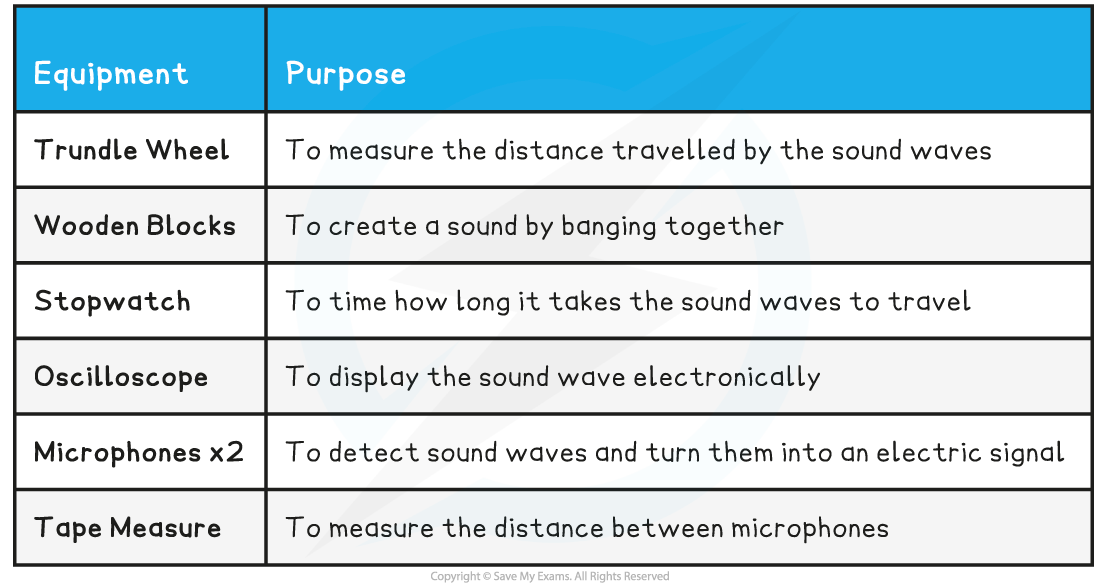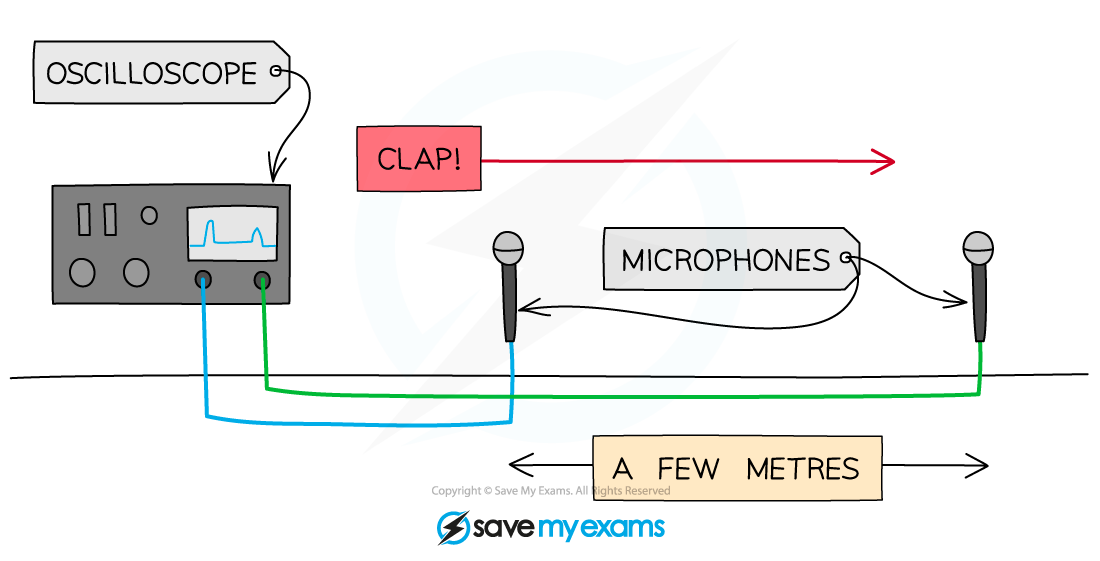Core Practical: Investigating the Speed of Sound (Edexcel IGCSE Physics)
Revision Note

Author
AshikaExpertise
Physics Project Lead
Core Practical 6: Investigating the Speed of Sound
Equipment List

- Resolution of measuring equipment:
- Trundle wheel = 0.01 m
- Tape measure = 0.1 cm
- Stopwatch = 0.01 s
Experiment 1: Measuring the Speed of Sound Between Two Points
- The aim of this experiment is to measure the speed of sound in air between two points
- Independent variable = Distance
- Dependent variable = Time
- Control variables:
- Same location to carry out the experiment
Method

Measuring the speed of sound directly between two points
- Use the trundle wheel to measure a distance of 100 m between two people
- One of the people should have two wooden blocks, which they will bang together above their head to generate sound waves
- The second person should have a stopwatch which they start when they see the first person banging the blocks together and stop when they hear the sound
- This should be repeated several times and an average taken for the time travelled by the sound waves
- Repeat this experiment for various distances, e.g. 120 m, 140 m, 160 m, 180 m
- A possible results table might look like this:

Analysis of Results
- The speed of sound can be calculated using the equation:

- The speed of sound in air should work out to be about 340 m/s
Experiment 2: Measuring the Speed of Sound with Oscilloscopes
- The aim of this experiment is to measure the speed of sound in air between two points using an oscilloscope
- Independent variable = Distance
- Dependent variable = Time
- Control variables:
- Same location to carry out the experiment
- Same set of microphones for each trial
Method

Measuring the speed of sound using an oscilloscope
- Connect two microphones to an oscilloscope
- Place them about 2 m apart using a tape measure to measure the distance between them
- Set up the oscilloscope so that it triggers when the first microphone detects a sound, and adjust the time base so that the sound arriving at both microphones can be seen on the screen
- Make a large clap using the two wooden blocks next to the first microphone
- Use the oscilloscope to determine the time at which the clap reaches each microphone and the time difference between them
- Repeat this experiment for several distances, e.g. 2 m, 2.5 m, 3 m, 3.5 m
- A possible results table might look like this:

Analysis of Results
- The speed of sound can be calculated using the equation:

- The speed of sound in air should work out to be about 340 m/s
Evaluating the Experiments
Systematic Errors:
- In Experiment 2, ensure the scale of the time base is accounted for correctly
- The scale is likely to be small (e.g. milliseconds) so ensure this is taken into account when calculating speed
Random errors:
- A main cause of error in Experiment 1 is the measurement of time
- Ensure to take repeat readings when timing intervals and calculate an average to keep this error to a minimum
- Maximise the distance between the two people where possible. This will reduce the error in measurements of time because the time taken by the sound waves to travel will be greater
Exam Tip
When you are answering questions about methods to measure waves, the question could ask you to comment on the accuracy of the measurementsIn the case of measuring the speed of sound:
- Experiment 2 is the most accurate because the timing is done automatically
- Experiment 1 is the least accurate because the time interval is very short
Whilst this may not be too important when giving a method, you should be able to explain why each method is accurate or inaccurate and suggest ways of making them better (use bigger distances)
- For example, if a manual stopwatch is being used there could be variation in the time measured which can be up to 0.2 seconds due to a person's reaction time
- The time interval could be as little as 0.3 seconds for sound travelling in air
- This means that the variation due to the stopwatch readings has a big influence on the results and they may not be reliable

You've read 0 of your 0 free revision notes
Get unlimited access
to absolutely everything:
- Downloadable PDFs
- Unlimited Revision Notes
- Topic Questions
- Past Papers
- Model Answers
- Videos (Maths and Science)
Did this page help you?